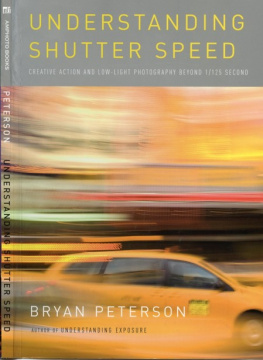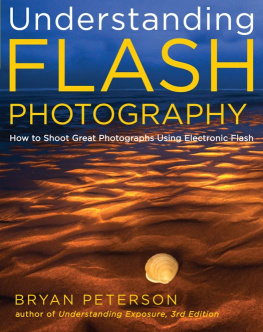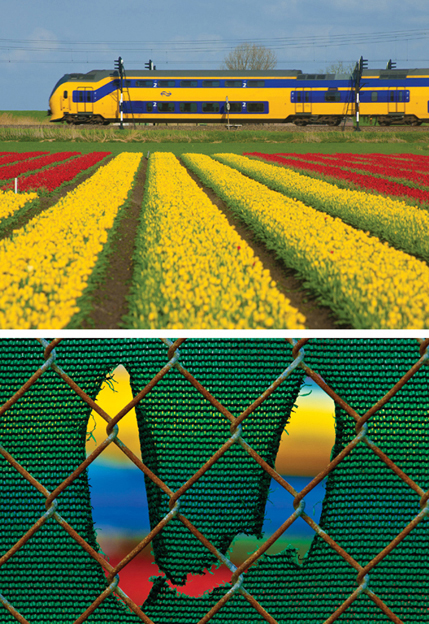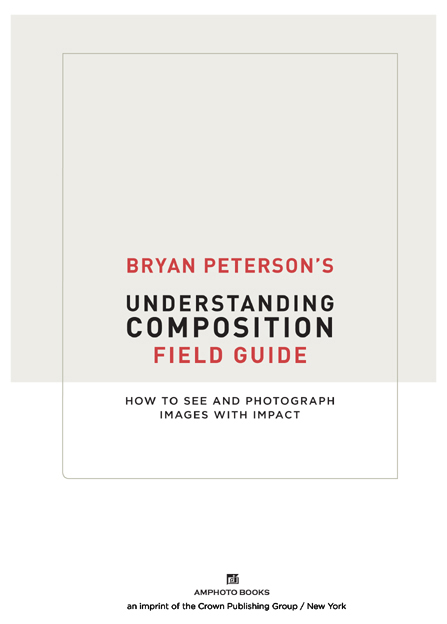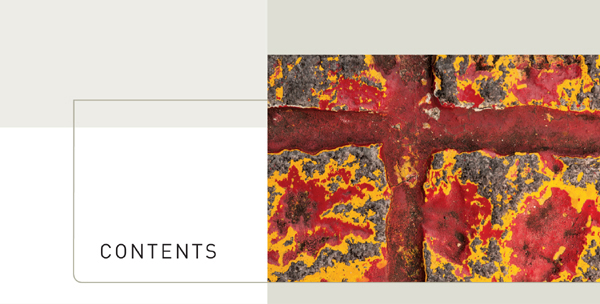Copyright 2012 by Bryan F. Peterson
All rights reserved.
Published in the United States by Amphoto Books, an imprint of the Crown Publishing Group, a division of Random House, Inc., New York.
www.crownpublishing.com
www.amphotobooks.com
AMPHOTO BOOKS and the Amphoto Books logo are trademarks of Random House, Inc.
Some of the photographs in this book originally appeared in previous Bryan Peterson publications.
Library of Congress Cataloging-in-Publication Data
Peterson, Bryan,
Bryan Petersons understanding composition field guide / Bryan F. Peterson.
p. cm.
Includes bibliographical references and index.
1. Composition (Photography) I. Title.
II. Title: Understanding composition field guide.
TR179.P466 2012
770dc23
2012007279
eISBN: 978-0-7704-3308-6
v3.1



Put fear aside, allow yourself to be blinded by your passion, and soon you will see!
Nikon D3X with Nikkor 70300mm lens, f/11 for 1/100 sec., ISO 200
What constitutes an amazing image? If you ask nature photographers, they might describe an image of Half Dome at Yosemite shot in inclement weather when, as luck would have it, the clouds parted just enough to allow several shafts of low-angled, late-afternoon light to cast an incredible glow across its face. If you ask fashion photographers, they might describe an image of a model who, while running on a sandy beach, leapt into the air at exactly the same moment that a large ocean wave crashed into a rock behind her. If you ask newspaper photographers, they might describe an image of a family whose tearstained faces encompass a large part of the foreground, while over their shoulders you can see the remnants of their house, reduced to smoldering ashes.
All three of these images do sound amazing, and yet without the actual photographs in front of us, we can only trust that they are as incredible as described. Or maybe they arent! Although the content of all three images suggests amazing, it is entirely possible that they are far from compelling, without impact, without emotion. How could that be, when clearly what I have described sounds like three amazing images? Because compelling photography is, first and foremost, not about the content! Compelling photography is about the arrangement of content.
This is a book about the language of that arrangement and how that language also speaks volumes about you, since I am firmly convinced that every image you will ever take is a revealing self-portrait of the inner you and all that goes on inside you. As you frame each and every image you take, each individual arrangement reveals a snippet of the inner you; the you that is driven or indecisive, passive, sorrowful, ambitious, elusive, impulsive, spontaneous, balanced, warm, integrated, angry, and so on. Photographic composition is a lifelong journey that reflects various passages over time if you know where and how to find the cluesclues that I will share with you in this book.
Technical know-how is good but far from liberating. True photographic freedom comes from a willingness to look at the world through a virgin eye. I cant stress those two words enough: willingness and virgin. Each one of us is born with virgin eyes, though it isnt long before well-meaning parents and teachers have shaped our vision: whats good, whats bad, whats pretty, whats ugly, what is a turnoff, what is compelling. The aim of this book is simple: no matter how mundane or ugly the content of an image might be, it is the arrangement of that contentwhat is known as compositionthat makes for compelling imagery.
Whether you are shooting garbage, Half-Dome in Yosemite, a fash-ion model, or a stricken family, a compelling image awaits if you understand the rules and nuances that every successful arrangement relies on. Sometimes it is a simple matter of filling the frame. As I have often said when viewing a students work, You are two feet short of a compelling image! Put another way: walk closer to the subject to better the fill the frame, and dont ever forget that the cheapest and most reliable zoom lens is your feet! Other times you will call on the Rule of Thirds, or simply switch the camera from its more comfortable horizontal position to a vertical position. Maybe your subject will benefit from tilting the camera at a 45-degree angle; then again, maybe the problem is all that distracting contrast, a wrong choice in aperture, a stale point of view, or an image that is a wee bit soft.
Additionally, there are a number of visual exercises in this bookalarm clocks, if you willdesigned to train even the most untrainable eye not only to see but to successfully arrange content in a compelling manner each and every time. These alarm clocks will awaken the creative vision that lies within each of us, even those who claim to be the deepest sleepers among us all!
Nikon D3X with 2485mm lens, f/16 for 1/125 sec., ISO 100
TAKING CONTROL OF YOUR IMAGES
Most of us are familiar with the software Photoshop and perhaps even the term layers. Layers is a Photoshop feature that allows you to stack two or more images atop one another and, by using a mask, blend elements from one image onto another to create an all-new image. It is a technique called on more and more by amateurs and professionals alike in their quest to create the ultimate image.
Perhaps if I were starting my career today, I would be a die-hard Photoshop layers kind of guy, if only because the possibilities are truly endless. But I have been doing my thing for so long now that my ideas and approach are firmly entrenched in the get it done in camera mentality. This means a careful and sometimes methodical approach to seeing layers, from the background to the foreground, along with choices about lens, point of view, time of day, and the addition of or subtraction of objects or props, into a final arrangement in camera.






